Twins top 20 prospects 2023: Keith Law ranks Minnesota’s minor league farm system

It was a tough year on the farm for the Twins, with many of their top prospects dealing with injury setbacks, including three guys who were once in the top 100 but didn’t make it this year. There’s still hope for many of those guys if they get healthy and/or make adjustments with the help of the Twins’ player development folks, and there’s also some upside way down in the Dominican Summer League and Florida Complex League.
MLB prospect rankings 2023: Keith Law’s complete guide to every farm system
The ranking
1. Emmanuel Rodriguez, OF (Top 100 ranking: No. 48)
The Twins gave Rodriguez $2.75 million to sign him in 2019, then had to wait until 2021 for him to debut, skipping him over the DSL and sending him right to the complex in Fort Myers, where he hit .214/.346/.524, showing big power but in-zone whiffs. Rodriguez went to Low A to start 2022 and showed enormous progress in his approach, hitting breaking stuff far more often and laying off more pitches out of the zone, drawing 57 walks in 47 games and hitting .272/.493/.552 before tearing the meniscus in his right knee on a slide in June. The surgery ended his season, but he still finished seventh in the Florida State League in walks and tied for 20th in homers even though he played in fewer than half of his team’s games before having season-ending surgery. It is huge raw power with an explosive swing, but at the same time, he’s very under control, which is unusual for lots of power hitters — except for some of the elite ones. He’s playing center now but the odds are strong he’ll end up in right. He needs more reps, and if he had a weakness last year, it was against changeups, but he might be a top-10 prospect in baseball by midseason if what we saw last spring holds up.
2. Brooks Lee, SS (No. 51)
Lee was the best college player in this year’s draft class and would have been a worthy pick at No. 1, coming off two years of stellar performance playing for his dad at Cal Poly. He has exceptional hand-eye coordination and seldom misses fastballs in the zone, striking out just under 10 percent of the time last spring and only 16 percent of the time in his pro debut in High A. It’s an unorthodox swing with visible effort, which has meant he has a lot of medium-quality contact, and probably projects to just average power unless something significant changes. On defense, he has outstanding hands and instincts, but he’s a below-average runner and doesn’t have the agility for shortstop, while he should be above-average at third or second. He’ll get the most out of his skills because he grew up around the game and seems to have an exceptional idea of the strike zone, so while he doesn’t have a superstar ceiling, he could be a high-average/high-OBP regular at third or second who hits 10 to 15 homers a year.
Age:
Bats: Right | Throws: Right
Drafted: No. 1 in 2017
Lewis makes the Anderson family look positively fortunate. He tore the ACL in his knee for the second time, ending his season after just 46 games — the only games he’d played since 2019. Lewis cleaned up his swing substantially while he was rehabbing from the first surgery, as the Twins helped him get rid of his pointless leg kick and reduced the big hand hitch, so while the sample wasn’t large the offensive breakout last year was most likely for real. He hit .313/.405/.534 in Triple A, and a respectable .300/.317/.550 in 12 games in the majors, even running well despite the first knee injury. The bat is here, so the main question now is where he’ll play: He wasn’t a capable shortstop before the knee problems, and now he’s lost most of two years while the Twins just signed a long-term solution at the position. He could move to third, or he could move to the outfield; his speed would play in center, although the Twins also have a reasonably fast guy there already. His value depends mostly on where he ends up playing; in center or even at third, he has a chance to be a star, but we have to see him play somewhere other than shortstop first.
4. Austin Martin, SS
Martin’s two years in pro ball have been marred by multiple injuries and a change in his approach where he’s trying to avoid swinging and missing, even at the cost of contact quality. The fifth overall pick in 2020, Martin was a high-contact hitter at Vanderbilt as well, playing plus defense at third before moving to short in his draft year before he developed a throwing issue that hasn’t completely gone away. He’s also had multiple hand and wrist injuries in pro ball, which doesn’t help a player’s power, although in this case, the problem is the swing rather than his hand strength. His swing is very short, often inside-out, so he makes soft contact and often just goes the other way rather than trying to drive something to the gaps (or beyond). The Twins have worked to get him to use his selectivity to get to a pitch he can hit hard, with success in a limited sample in the AFL. I think he’s best suited to second base, and could still get to a high-average/high-OBP level that makes him a strong regular or an above-average one. It’s really up to him at this point to make the adjustment at the plate.
5. Jose Salas, SS
Acquired in January in the trade that sent Luis Arraez to Miami for Pablo Lopez and Byron Chourio, a deal I love for the Twins in part because they got Salas in it. Born in Florida but raised in Venezuela, Salas is a tooled-up shortstop with plus-plus speed (33-for-34 in stolen bases last year) and an advanced approach at the plate for his age, but he needs to work on contact quality by getting stronger in both his upper and lower halves. There’s risk, and you can see from Austin Martin what happens to guys who don’t hit the ball hard enough, but he has above-average everyday upside.
Age:
Bats: Left | Throws: Right
Drafted: No. 539 in 2019
Julien is a hard prospect to evaluate because his best skill is one that can be a huge asset or a cover for one’s deficiencies: He walks, a ton. He walked three times while you read that sentence. (I concede the point that my sentences are long. The point stands. And my friend Marcel said my sentences are fine.) Julien walked 110 times in 2021, and 98 times last year, striking out in a quarter of his plate appearances in 2022 with solid-average power. He makes some quality contact, and last year worked on swinging earlier in the count, in relative terms, with positive results. He’s defensively challenged, a reach at second base, more likely to end up in left field. A .400 OBP would play pretty much anywhere, especially attached to even fringy power. The fact that he carried this over to Double A gives a little more reason to believe he can be a productive big leaguer, maybe even a regular.
Age:
Bats: Right | Throws: Right
Drafted: No. 153 in 2016
Balazovic had a knee injury right before the lockout began and, as part of the 40-man roster, had no access to the Twins’ doctors or conditioning staff, so when the lockout ended and play resumed, he wasn’t ready and his command was way off. The result was a predictable disaster: a 7.39 ERA with 20 homers allowed in 70 2/3 innings in Triple A. His fastball got hammered and he didn’t hold his velocity, likely because he lacked strength in the knee. The small bit of good news is that he finished strongly, bringing his ERA down from 11.12 on Aug. 4, his highest of the season, with better but not great peripherals the rest of the way. I’m writing the year off as a matter of injury and hoping he gets back to the top-100 form he’d shown in 2019 and 2021, where he looked like a potential No. 2 starter.
8. Connor Prielipp, LHP
Prielipp underwent Tommy John surgery partway through the 2021 college season, but before that he was at least good enough to talk about him as a possible first overall pick in ’22. The Twins took him in the second round in 2022, which will be a steal if his stuff comes all the way back. He didn’t look 100 percent when he threw for teams before the draft, but threw well in instructs, and by the time he pitches in a game it’ll be almost two full years since the operation. Pre-surgery, he was low- to mid-90s with a plus slider and 55 changeup, with deception from a low three-quarters slot but a delivery that brought him back across his body. If he’s healthy, he’s a potential No. 2 starter. There’s more reason to worry about him holding up than the average TJ recipient, though.
9. Tanner Schobel, SS
Schobel was the Twins’ second second-round pick in 2022, a strong college performer at Virginia Tech who offers a high floor given his advanced approach and compact swing. He hit for power in college, but so did everyone in 2022; the swing and lack of physical projection point more toward doubles power in pro ball. He might stay at shortstop and become a regular who gets on base at an above-average clip or move off the position and become a super-utility guy whose bat is good enough for 400-plus plate appearances a year.
Age:
Bats: Right | Throws: Right
Drafted: No. 48 in 2018
I was never the biggest Woods Richardson fan due to his delivery, where his arm is very late relative to his front leg and his breaking stuff isn’t sharp as a consequence, but his velocity dropped last year to where he was averaging 90-91 mph. He does throw strikes, and he has some added deception from the differing spin-based directions of his fastball and his curveball, but there isn’t a plus pitch here and the four-seamer lacks life. I think he’ll struggle with hard contact — although, to be fair, he didn’t have that problem at all in Triple A — and end up a back-end starter or a reliever.
11. Yasser Mercedes, OF
Mercedes signed in January of 2022 for $1.7 million, a Puerto Rican native who grew up in the Dominican Republic and thus signed as an international free agent rather than coming through the draft, probably making a lot more money in the process. He mashed in his debut, hitting .355/.421/.555 in the DSL with 30 steals in 41 games. He’s a plus runner who’s a solid centerfielder now, although as he gets bigger he might end up in a corner. At the plate, he has loose, easy hands with impressive bat control, showing great balance, more a hitter than a power guy even with the big output last summer. There’s a chance he stays in center and gets to 18-20 homers with high batting averages, or maybe grows to get to more thump and ends up a corner.
12. David Festa, RHP
Festa’s a skinmy starter whose velocity ticked up last year to 93-98 mpg, paired with a plus changeup and an improved but still fringy slider. He has some room to fill out, although the issue with the fastball is less velocity than the contact he allows on it, and he may need a fourth pitch or just further progress on the slider. He has No. 4 starter upside depending on how those things progress.
13. Marco Raya, RHP
Raya was the Twins’ fourth-round pick in 2020, missed all of last year with shoulder soreness, then debuted last year in the Low-A Florida State League. He’s up to 98 mph with a hammer curveball and slider that might end up a … another hammer, I guess. He does need to improve his changeup, and stay healthy, of course, which some folks question given his size and slighter build. He has third-starter upside with low probability, with a good floor in the bullpen as long as he holds up.
14. Misael Urbina, OF
Urbina had a lost season, missing more than half the year with visa issues and underperforming when he returned, even running a bit worse. He’s going to have to work to stay in center, including maintaining his conditioning, while he can show average-ish power but probably not enough for a corner.
Age:
Bats: Left | Throws: Right
Drafted: No. 39 in 2019
Wallner has an 80 arm and plus raw power with terrible pitch recognition — the man just does not hit offspeed stuff anywhere near often enough to be a regular, with massive strikeout rates last year: 30 percent in Triple A, 38.5 percent in the majors. He has enough plate awareness that he might have some chance to eke out a career as an extra outfielder, and if he’d be willing to pitch again as he did in college, he’d increase his odds. I just don’t see where this goes if he can’t pick up anything other than a fastball.
Age:
Bats: Left | Throws: Right
Drafted: No. 449 in 2019
Varland made the majors last year as a starter but projects as a bullpen guy, with a four-pitch mix but nothing to miss bats. He throws strikes with average command, not enough to get him by as a starter even at 93-94 mph. I’d like to see if his stuff ticks up at all in relief.
17. Noah Miller, SS
Miller can work the count and play shortstop, but he has no impact at all right now with the bat, with just 18 extra-base hits in 108 games in Low A last year. He might be a shortstop defensively, and with his eye at the plate, he’ll get a long time to figure out better contact, with room to add some strength to at least be a competent hitter for average. He has the upside of a regular, but the floor is a guy who can’t slug .300 in Double A and never advances beyond it.
18. Jose Rodriguez, OF
Rodríguez led the DSL with 13 homers last year as a 17-year-old, just a few months after he signed for a $650,000 bonus, but fortunately it’s not all slug as he has a decent approach. He’s a right fielder but could end up a 50/55 defender there if he maintains his body, with a big 6-foot-2 frame that’s already strong for his age. If he keeps his contact up when he goes to the FCL this year, he’ll shoot up the list.
19. Danny De Andrade, IF
De Andrade signed for $2.2 million in January of 2021 out of Venezuela, as more of a skills guy than a high-ceiling toolsy teenager. He has excellent bat-to-ball skills and has worked with the Twins to improve his pitch and ball/strike recognition so he would swing at better pitches. He has excellent hands and should stay in the middle infield, more likely at second base, although his arm plays up anywhere because it’s accurate. He has to get stronger so he can convert all this contact into higher batting averages, which gives him an everyday ceiling.
Age:
Bats: Right | Throws: Right
Drafted: No. 54 in 2019
The Twins chose to protect Canterino even though he underwent Tommy John surgery in August. He has the arsenal to start with potentially multiple out pitches, but he has no history of staying healthy in pro ball, with 85 total innings in three minor-league seasons, and once he returns, he’ll be 26 and he should probably go to the bullpen.
One more of note: The Twins picked up right-hander Alejandro Hidalgo from the Angels in November for Gio Urshela. Hidalgo was hurt for most of 2022, making his last start on June 11, but he’s got plus velo on a riding fastball and an above-average changeup, striking out a third of batters he faced in low A while walking 11% at age 19. He’s a long shot but there are starter elements here.
2023 impact
Varland could make the bullpen, as could Woods Richardson, although either could also start in Triple A and be called up to make a spot start.
The fallen
I always liked Blayne Enlow, whom the Twins drafted in the third round in 2017 and signed to an over-slot bonus, but his stuff hasn’t come all the way back after Tommy John surgery and the Twins outrighted him off the 40-man this winter.
Sleeper
Mercedes checks a ton of boxes as someone with some present skill, a position up the middle, and the tools to give him real upside.
(Top photo of Emmanuel Rodriguez: Mike Janes / Four Seam Images via AP)




































